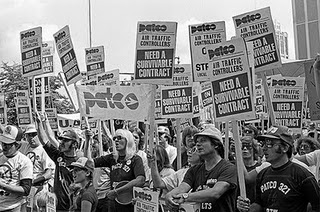Now, I wouldn't normally engage in such lowly politicking, particularly when we shouldn't be surprised by who is spewing such nonsense into the blogosphere. But since my reply has a historical component to it, I thought, why not.
THIS IS WHAT CLASS WARFARE LOOKS LIKE
Over the course of the late-19th century and into the early 20th, court injunctions (orders) against unions, instead of a full trial, became increasingly common across the U.S. as businesses, backed by the judicial system, took more forceful measures against labor. Many of these issues were intended to be solved by the New Deal in the 1930s which, particularly in 1936, provided an institutional space in which capital-labor disputes would be subject to rules, regulations, and a fair trial.
Launching us into the so-called "golden age of American capitalism" where high productivity was matched by rising living standards for workers across the board, these New Deal institutions were symbols of a "capital-labor accord". Except that such stringent victories for labor hardly meant a truly more democratic economy -- while democracy on the workfloor is arguably the whole point of a labor movement, the voices and contracts of the golden age had been reduced to asking for yearly wage increases and increased profit-sharing. And then, even that began to change, as the unions themselves began to die out -- union membership began declining in the 70s and 80s.
Ronald Reagan made sure to maintain that trend in 1981:
That's what class warfare looks like.
If you want to know what redistribution looks like, see the following:
-8 hour workday
-Job benefits including health care and retirement funds
-Public education at affordable costs
Doesn't look like class warfare to me!!!!



My objection with the current usage is more to do with the term warfare than anything else.
ReplyDeleteIt would be warfare if Obama (preferably dressed in camouflage) scaled the fence of a wealthy American's compound, chiseled some of the 14k gold off of the edge of the swimming pool and then shared it with the middle class. At least there would be the potential for some violence.
On the bright side a search for "lamest war ever" yielded this gem of the modern age:
http://www.youtube.com/watch?v=to-Axw5VcHE